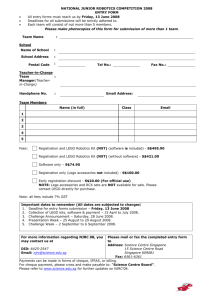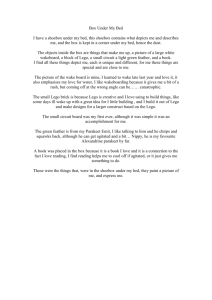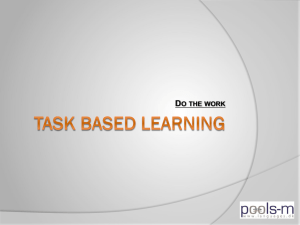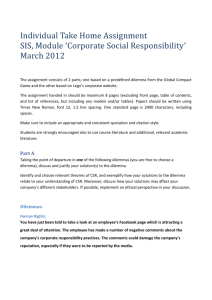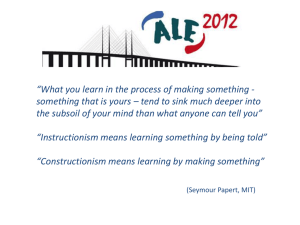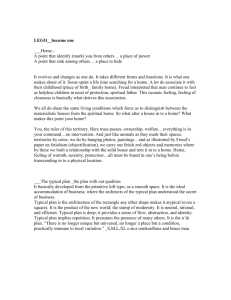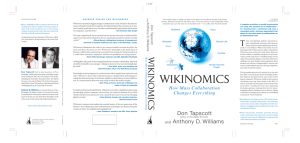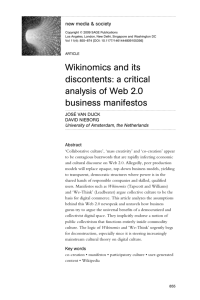Wikinomics
advertisement
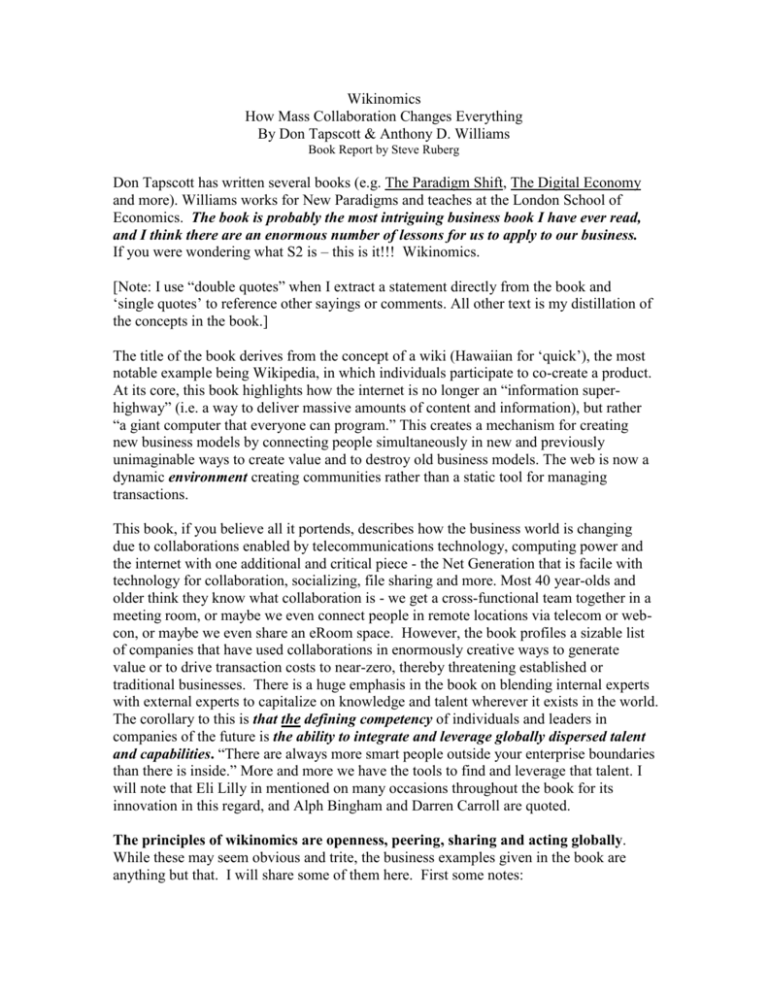
Wikinomics How Mass Collaboration Changes Everything By Don Tapscott & Anthony D. Williams Book Report by Steve Ruberg Don Tapscott has written several books (e.g. The Paradigm Shift, The Digital Economy and more). Williams works for New Paradigms and teaches at the London School of Economics. The book is probably the most intriguing business book I have ever read, and I think there are an enormous number of lessons for us to apply to our business. If you were wondering what S2 is – this is it!!! Wikinomics. [Note: I use “double quotes” when I extract a statement directly from the book and ‘single quotes’ to reference other sayings or comments. All other text is my distillation of the concepts in the book.] The title of the book derives from the concept of a wiki (Hawaiian for ‘quick’), the most notable example being Wikipedia, in which individuals participate to co-create a product. At its core, this book highlights how the internet is no longer an “information superhighway” (i.e. a way to deliver massive amounts of content and information), but rather “a giant computer that everyone can program.” This creates a mechanism for creating new business models by connecting people simultaneously in new and previously unimaginable ways to create value and to destroy old business models. The web is now a dynamic environment creating communities rather than a static tool for managing transactions. This book, if you believe all it portends, describes how the business world is changing due to collaborations enabled by telecommunications technology, computing power and the internet with one additional and critical piece - the Net Generation that is facile with technology for collaboration, socializing, file sharing and more. Most 40 year-olds and older think they know what collaboration is - we get a cross-functional team together in a meeting room, or maybe we even connect people in remote locations via telecom or webcon, or maybe we even share an eRoom space. However, the book profiles a sizable list of companies that have used collaborations in enormously creative ways to generate value or to drive transaction costs to near-zero, thereby threatening established or traditional businesses. There is a huge emphasis in the book on blending internal experts with external experts to capitalize on knowledge and talent wherever it exists in the world. The corollary to this is that the defining competency of individuals and leaders in companies of the future is the ability to integrate and leverage globally dispersed talent and capabilities. “There are always more smart people outside your enterprise boundaries than there is inside.” More and more we have the tools to find and leverage that talent. I will note that Eli Lilly in mentioned on many occasions throughout the book for its innovation in this regard, and Alph Bingham and Darren Carroll are quoted. The principles of wikinomics are openness, peering, sharing and acting globally. While these may seem obvious and trite, the business examples given in the book are anything but that. I will share some of them here. First some notes: Openness means sharing even what has been traditionally proprietary; it requires standards and “porous” company boundaries; Peering is the collaboration of peers in a structured way and is self-organizing of masses of people rather than hierarchical command and control; Sharing is opening up your intellectual property to others and letting others generate value that you cannot do yourself; Acting globally means that you have a global workforce, unified global processes, a global IT platform etc. My question is: Are you global, or just all over the map? The authors write, “These four principles …increasingly define how twenty-first-century corporations compete. This is very different from the hierarchical, closed, secretive, and insular multi-national that dominated the previous century.” Furthermore, “We must collaborate or perish – across borders, cultures, disciplines, and firms, and increasingly with masses of people at one time.” It is well understood that price is something that emerges from any free marketplace. That is, no one person/company sets the price of a good or service; it is the collective, competitive market pressures that drive and ultimately set the price. It is a natural result of a self-organizing system. Now, companies are realizing that this concept of emergence can be intentionally (as opposed to being an un-intentional by-product of a system) applied to broad collaborations in many different ways to produce a self-organizing system/product that is better than any one group could create. There is a certain “wisdom of the crowds.” The authors reference Ronald Coase’s paper written in 1937 entitled “The Nature of the Firm.” [Note: This is the best business paper I have ever read, which also has broad implications for our business. If you need a copy let me know.] Coase basically asked the question ‘why do firms do some work themselves and buy/contract with other companies to do other work?’ For example, Ford Motor Company of yester-year bought desks, paper and other office supplies, but owned their own rubber plantations in South America for the tires on their cars. Why didn’t Ford make its own desks/paper or own forests? He logically extrapolated to the question ‘why do people join a company instead of contracting their services on an as needed basis to do a specific job?’ This is the equivalent of the movie-making industry in which actors, set-designers, costume makers, sound crews, etc. collaborate to make a movie and the ‘break-up’ to find the next movie. The answer Coase surmised was transaction costs. In the first example noted above, if it cost a firm more time and money to do something externally than internally, then it was better to own it and do it than to buy it. [Note: an insight of Coase was that this also applied to the flow of information. Tracking long-distance activities, finalizing contracts etc. took an enormous amount of time since mass and immediate communication was largely unavailable at that time.] In the second example, Coase noted that the transaction costs of recruiting and training people and making individual contracts made it more expeditious to ‘own’ the people rather than ‘rent’ the people on an as needed basis. Coase’s superior insight at the time was that as transactions costs (the flow of workers, goods and information) decreased, the nature of the firm would change and we would see more partnerships, joint ventures, virtual companies, etc. (he did not use these terms but conveyed these concepts). For this insight he won the Nobel Prize in economics in 1991 as the Internet was emerging. “The most important lesson to take away for the moment is that emergent phenomena tend to win in the marketplace. Ten thousand interoperating agents can often marshal more bandwidth, more raw intelligence, and more requisite variety than the largest organization. The business challenge is to form – even to foster - symbiotic relationships with emergent structures, since the fundamental nature of self-organization is that it cannot be controlled easily, but it can be steered. “Smart firms are thinking carefully about how to navigate the field of open versus proprietary technology … This is particularly important in areas like innovation and knowledge management …” The authors identify several categories of models involving “weapons of mass collaboration” organized into separate chapters. In my opinion, some of these categories overlap or are not entirely distinguishable, but then again each category has as its basis the same concept - mass collaboration. Peer Pioneers There are well-known open source products that have become mainstream in the marketplace - software like Linux and information like Wikipedia. Linux was created and is run by Linus Torvalds and a small group of people who manage the software contributions of thousands of programmers around the world to make an operating system that rivals Microsoft. IBM contributes about $100 million to Linux development for free but makes over $1 billion in consulting services related to Linux implementation. Had I BM continued in its traditional path of creating software, it figures it would have needed 5-10 times that investment to develop and maintain its own operating system let alone marketing and selling it against Microsoft. Wikipedia is an on-line encyclopedia that is the largest encyclopedia in the world, offered for free and created entirely by volunteers. It is about 6 years old and has more content with equivalent accuracy to Britannica (based on Nature magazine’s comparative analysis). All this is done with 5 full-time employees. On average, an obscenity randomly posted in Wikipedia is removed in less than 2 minutes by another contributor. The wisdom/power of the crowd swarms toward new or inaccurate entries, vandalism or defamation, and so-called edit wars, etc. and fixes them faster than any editorial board could ever do. The benefits to peering are harnessing external talent, keeping up with users/customers, boosting demand for complementary offerings, reducing costs, shifting the locus of competition, taking friction out of collaboration, and developing social capital. The business question is “… If as an entrepreneur, I open source my product or technology, how do I make money from an asset that I no longer control?” More and more companies are finding ways to do this. Ideagoras This term is taken from the bustling Greek marketplaces known as ‘agoras’. It is the concept of using the world as your marketplace for ideas and talent. InnoCentive is the quintessential example in this section, and Eli Lilly is highly recognized in this regard. “The world is your R&D Department. … The deep-rooted ‘plan and push’ modality will give way to a new approach to innovation where companies engage and co-create with the best available talent, wherever it is in the world.” “Acquisitions, alliances, joint ventures, and selective outsourcing are simply too rigid, and not scalable enough, to drive growth and innovation at a level that will make companies truly competitive.” Perhaps one of the most striking examples in the book is that of Goldcorp, a stagnant gold mining company. They were facing less gold in their mines and higher costs to extract it. Against the advice of most internal folks, the CEO made the bold decision to open up the company’s most confidential and proprietary asset – its geologic data. This data had been analyzed incessantly by internal geologists and scientists without yielding new information about where or how to find additional gold on their property and in their mines. Within 2 weeks of the release of all the data publicly, Goldcorp received numerous analyses, models, predictions, and approaches for how to find more gold, where to drill, and how to extract it efficiently. They reviewed submissions, paid rewards for those that were most promising and pursued the best ideas. Goldcorp has gone from a $300MM company to a $3B company (10-fold growth) in about 3-4 years. It also has more gold to mine than it had ever dreamed and will be profiting from their existing mines for years to come. Before launching an “ideagora” companies need to understand and define clear goals and guidelines for what kind of idea marketplace they want to create and how they will derive value from that marketplace. “Smart firms will build their R&D organizations around a core of question askers and outsource most of the problem solving.” Prosumers The line between consumers and producers is blurring in some areas. The most notable example in this category is Lego. A prosumer approach is not to be confused with customer centricity - where producers pay close attention to customer needs and allow customers to select from a variety of features to ‘customize’ a product. Prosumerism is allowing the customer to co-create products with you and to share them with other customers. In 1998, Lego released a product with programmable pieces to turn its interlocking blocks into programmable robots and machines. Shortly after the release of the product, consumers starting hacking the software and creating their own programs to do much more than what Lego engineers had designed. Initially, Lego threatened to sue those who were ‘violating’ their software license, but quickly reversed their position when they realized that they had an enormous source of creativity to co-develop their toy. Lego now has a web-site (mindstorms.lego.com) where users can share software for programming Lego toys. Furthermore, Lego offers free downloadable development software so that consumers can easily make new creations and share them with other consumers. “It’s a bit like open source Lego.” “Lego’s fusion of mass customization and peer production remains rare enough in today’s consumer products market to make the idea particularly outstanding.” Strategically, Sony PlayStation and Apple iPod, for example, have decided not to take this path of opening up their systems for remodeling and co-creation by others. To date, they are controlling their inventions because they see more value in having a dominant proprietary approach rather than an open approach where value is gained by sharing the ‘wisdom of the crowd.’ We will see how long this last, especially since Apple failed with this approach 2 decades ago with the PC. “Industry must come to a realization that they can hold a great deal more in an open hand than they can in a closed fist.” Another example of prosumerism is the reader-compiled on-line news called digg. Stories are posted by the masses and readers vote on stories that are good or send them to their friends. The more activity a story gets, the more it gets promoted to the ‘front page’ of the on-line news. Presently, about 150,000 users contribute to digg. The readers are also the producers. New Alexandrians This comes from the early Greeks who wanted to create the greatest library that contained all the knowledge of the world – books, histories, literature, science, etc. – the fabled library at Alexandria. The most notable example of this is Google, which is compiling huge libraries of digital information. The authors state the human knowledge doubles every 5 years. [Note: I have read that human knowledge doubles approximately every 3 years, and has been doing so for as far back as anyone can evaluate. Of course, that means that 90% of everything we know today has been discovered in the last 10 years – and that statement is true at anytime in the course of history.] The Earth System Grid (ESG) is building huge database from weather station grids documenting the Earth’s weather. There is the Human Genome Project as another open source of rich genetic information. The European Bioinformatics Institute is revolutionizing the integration of vast amounts of biological data from very different data sources – genetics, geographic distribution, taxonomy/lineage, etc. GenBank has a repository of 100 gigabytes of genetic code on 165,000 organisms, which will allow us to map entire ecosystems, not just individual organisms. Interesting statement: “These microscopic spirals of DNA amount to something like an operating system for humans.” In this section Merck is cited for opening up its Merck Gene Index to the public as a way to keep genetic information from becoming controlled, closed or proprietary information for exploitation by private companies. There is a discussion about “open source drug discovery” with comments from Frank Douglas, formerly of Sanofi-Aventis. [Note: A former boss of mine.] Industry and university partnerships are advocated as a way to open up innovation and share risk. “Companies can’t open the kimono all of the time. Companies need to defend their assets and work hard to create proprietary advantages. … Keep the science open and the applications proprietary.” Platforms of Participation More and more companies are opening up their software by making APIs public and allowing others to integrate new functionality, capabilities or content that spawn whole new applications or an integrated delivery solution. eBay, Amazon and Google are good examples of this. When someone takes two or more applications and links their functionality to create a new tool, it is called a “mashup”. housingmaps is a mashup of craigslist (an on-line classified service with homes for sale) and Google Maps. The result is a mechanism to find houses for sale more easily. PeopleFinder was a mashup created for victims of Hurricane Katrina that was pulled together by volunteers in less than 4 days with no cost – only volunteer programmer time. It far surpassed anything FEMA or the Red Cross could do or did do. On its first day online it registered 50,000 people and helped locate them, and ultimately had an index of 650,000 people. It quickly became the reference point for government services for finding and helping people. eBay and Amazon allow others to run their sales business through their applications and interfaces for payments, processing and distribution. Besides getting a cut of the business, eBay and Amazon leverage these business partners which also create applications, thereby extending their own B2B capabilities. It’s like open source for business. The Global Plant Floor This chapter deals with amazing companies that are leveraging engineering design and manufacturing globally to assemble products such as motorcycles and airplanes. The best examples of this are Lifan, a Chinese motorcycle manufacturer, and Boeing. Lifan treats suppliers not as suppliers or even partners, but as peers. Their motorcycle is a collection of assemblages that are designed by suppliers who work in close collaboration with open specifications so that all the pieces come together quickly and easily in the end. But each ‘supplier’ is responsible for design and optimization and for openly sharing what it is doing. Lifan has taken 70% of Honda’s small Asian motorcycle business in less than 10 years and brought the cost of such a motorcycle down from $700 to $200 in that same time period. Boeing is doing the same thing with its new 787 Dreamliner aircraft. It is not outsourcing as Boeing has done before – it is open collaboration among designers of wheels, wings, cockpit, engines, etc. The electronics specification document for the Boeing 777 was 2500 pages alone and detailed everything that the ‘suppliers’ had to deliver in excruciating detail. The same specification for the 787 is 20 pages!! Everyone shares data and designs to insure the pieces all come together. It is the Linux version of building an aircraft. The final modular assembly process for the 787 will be a mere 3 days!!! “Innovation is less about inventing and building things and more about orchestrating or coordinating good ideas.” “Always strive to be the best at what your customer values most and partner for everything else.” For the most part, BMW doesn’t build cars anymore. It focuses on the driving experience and understands the customer interface - the look and feel of the car. More and more, it outsources all the actual building of the car. The Wiki Workplace “We are shifting from closed hierarchical workplaces with rigid employment relationships to increasingly self-organized, distributed, and collaborative human capital networks that draw knowledge and resources from inside and outside the firm.” Robert Stephens, the founder of the Geek Squad (which is uber-successful), says, “Instead of trying to set an agenda, I’m now going to try and discover their agenda [referring to his workforce of young, inquisitive, tech-savvy people] and serve it.” “Whereas previous generations value loyalty, seniority, security, and authority, the NGen’s norms reflect a desire for creativity, social connectivity, fun, freedom, speed, and diversity in their workplace.” [Amazing note: More than 100,000,000 young people from around the world hang out on MySpace, and the vast majority of people over the age of 30 have virtually no ideas what it is or is about.] “The ability to use wikis will be a required job skill in 5 years” – much like using e-mail is today. “Clear goals, structure, discipline, and leadership in the organization will remain as important as ever, and perhaps more so as peer production emerges as a key organizing principle for the workplace.” There will always be a need for some proximity and direct human interaction in which we all learn and communicate through subtle body language, intonation, etc. “The days of lifelong employment and pensions are already long gone. … Our work may still largely define who we are, but employers no longer will.” “In the new world of wikinomics, it turns out that just about anyone can be a leader.” Bottom line: Open up the boundaries of your firm to global resources, and share your knowledge so that you can attract and leverage talented people that are treated as peers.

